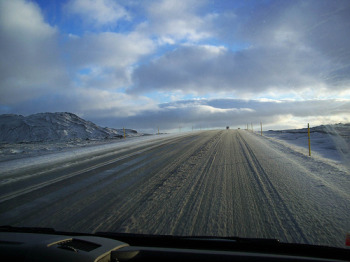Driving Iceland’s Ring Road
 By car is one of the best ways to see Iceland, and nearly anyone who visits the country will end up on the Ring Road, Route 1, at some point, especially if they plan on driving some or all of the 832-miles around the island.
By car is one of the best ways to see Iceland, and nearly anyone who visits the country will end up on the Ring Road, Route 1, at some point, especially if they plan on driving some or all of the 832-miles around the island.
Driving the Ring Road is one of the quintessential experiences in Iceland, but it’s not as easy as hopping in the rental and taking off. Here’s what you need to think about before you go.
Budget your time wisely. Sure, 832 miles doesn’t seem like that much. At 60 miles per hour, you could cover that in less than 16 hours – two days of 8 hours of driving each. But, there are two very important factors to consider. The first is that you can’t go 60 miles per hour. On paved rural roads, the speed limit is usually 90 km/h (about 55 mph), but in many areas it is much less.
There are lots of blind hills, shoulderless roads, and long stretches of gravel that will slow you down. Okay, you think, even if I go 40 mph, I can still make the loop in about 20 hours, or 3 days of a little less than 7 hours each. And that’s true, but that doesn’t account for any stopping for meals, gas, or even to partake in any activities. Think carefully about what you want to see along the way, and budget your time accordingly. Add in extra time for stopping simply to gaze at the scenery or take photos of landscape. And trust me, you will be stopping to do so often.
Remember that distances in Iceland can be deceiving. Though it may only look like a short distance between two towns (and in fact, it may only be a few dozen kilometers), the road conditions can make the drive much longer.
Be prepared. Once out of Reykjavik, petrol stations are few and far between. Keep that in mind and always top off your gas tank when you can. Arm yourself with a good map, and know which roads you can and cannot take your rental car on. There are big fines for taking your rental car onto a grade of road for which it is not rated. It’s a good idea in Iceland to spring for the extra insurance too. It’s also wise to pre-book your accommodation – in winter off-season many places are closed, and during the summer height of tourist season, many places sell out.
Check to make sure you have a spare and let your accommodation know when to expect you. Pack some warm clothes, some bottled water, and a some snacks, and if possible, travel with a cellphone. Should something happen along the road in a rural area, you may end up waiting a long time for another car to come along.
Photo by Night Owl City